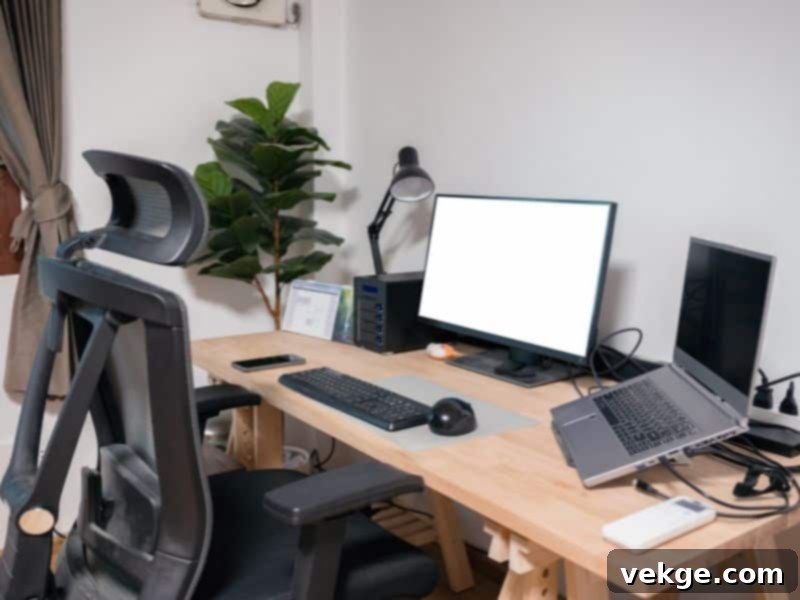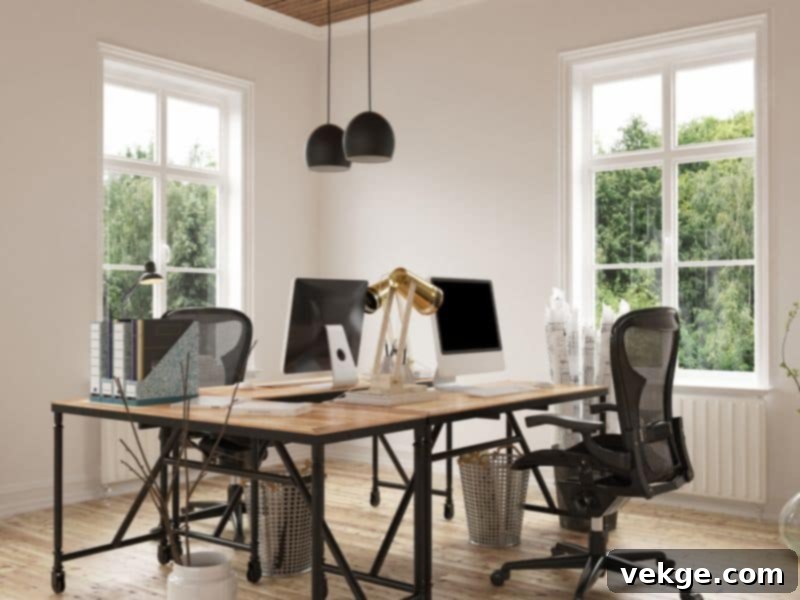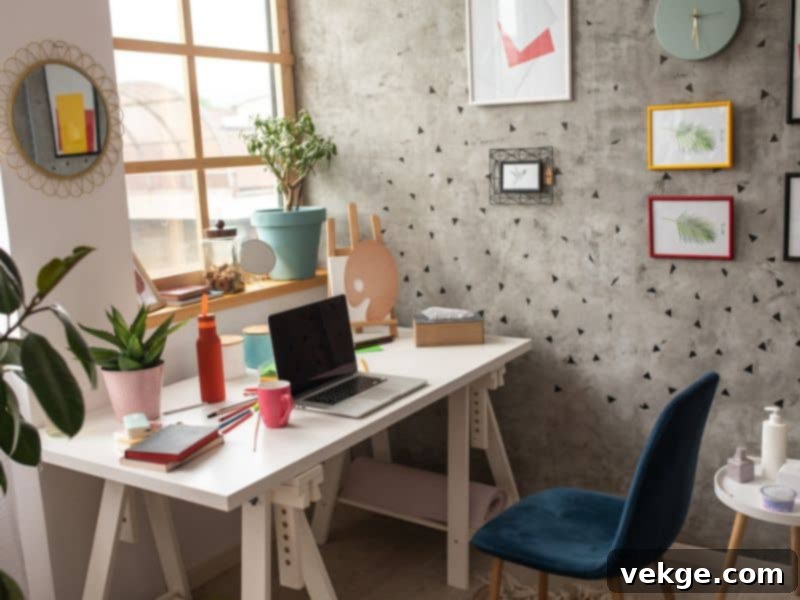The Ultimate Guide to Designing an Efficient and Productive Home Office
Creating an efficient and highly productive home office is no longer a luxury but a necessity for many modern professionals. A well-optimized workspace significantly boosts concentration, streamlines workflows, and ensures tasks are completed effectively, allowing you to maximize your output and minimize stress. The foundation of a productive home office lies in a strategic combination of thoughtful layout design, selecting the right ergonomic furniture, leveraging essential technology, maintaining optimal environmental conditions, and implementing consistent organizational habits. This comprehensive guide will walk you through each critical aspect, helping you transform your home workspace into a hub of efficiency and innovation.
Imagine a workspace where every item has its place, where comfort supports long hours of focus, and where technology seamlessly aids your work rather than hinders it. Such an environment reduces time wasted searching for items, minimizes physical strain, and cuts down on interruptions. By meticulously planning and investing in your home office, you can cultivate an environment that not only fosters productivity but also enhances your overall well-being and job satisfaction.
Designing Your Home Office Layout for Optimal Productivity
The physical arrangement of your home office plays a pivotal role in dictating your daily efficiency and overall comfort. Careful layout planning can significantly enhance productivity by optimizing space utilization and minimizing potential distractions. This section delves into selecting the ideal location, arranging your desk effectively, and making the most of vertical and wall spaces.
Selecting the Right Location for Your Home Office
The first and arguably most crucial step in designing your home office layout is identifying a location that offers minimal distractions. Proximity to natural light is a key factor; positioning your desk near a window can significantly boost your mood, improve visual comfort, and reduce eye strain. Studies have shown that access to natural light can even enhance cognitive performance.
It’s highly beneficial to establish your workspace away from high-traffic areas within your home, such as the kitchen or living room, which are often sources of frequent interruptions and noise. Prioritize privacy whenever possible. If a dedicated room isn’t an option, consider using creative solutions like room dividers, privacy screens, or even strategic furniture placement to create a clear boundary between your work zone and personal life. For smaller homes or shared living spaces, noise-canceling elements like heavy curtains or even a tucked-away corner can help define your personal office sanctuary, essential for maintaining uninterrupted focus.
Maximizing Desk Space and Placement for Efficiency
When arranging your office desk, think critically about your workflow and how you interact with your tools. The desk itself should be adequately sized to comfortably accommodate your computer, documents, and other essential items without feeling cramped or cluttered. Consider different desk types, such as L-shaped desks for more surface area or standing desks for health benefits.
Desk placement is equally vital. A desk facing a wall can minimize visual distractions, allowing you to concentrate solely on your screen or documents. Conversely, facing a window can offer a pleasant view and ample daylight, which can be invigorating. However, be mindful of glare on your screen. Keep frequently used items within arm’s reach by utilizing smart desk organizers, drawer units, and even under-desk storage. This simple habit dramatically reduces the time spent searching for materials, keeps your desktop tidy, and supports a seamless workflow. Ensure your workspace has a combination of ambient (general room lighting) and task lighting (direct light on your work area, like a desk lamp) to reduce shadows and glare on your screen, preventing eye fatigue.
Utilizing Vertical and Wall Space Efficiently
Vertical and wall spaces are often overlooked but offer immense potential for enhancing the functionality of any home office, particularly in smaller setups. Shelving units, whether freestanding or mounted, are excellent for storing books, binders, decorative items, and files without encroaching on valuable desk real estate. This helps maintain a clean and spacious working surface.
Innovative solutions like pegboards, magnetic boards, or even grid wall panels can transform empty wall sections into highly functional storage for tools, stationery, earphones, or notes, keeping them off your desk while remaining easily accessible. Consider investing in multi-functional furniture, such as a desk with integrated shelving or drawers, to maximize space utility. Floating shelves or wall-mounted cabinets can further expand storage options, allowing you to keep essential items like chargers, stationery, or reference materials within easy reach. This strategic approach to vertical storage is key to maintaining an organized, clutter-free work environment, which is inherently conducive to higher levels of productivity and focus.
Choosing the Right Furniture and Equipment for a Productive Office
Selecting appropriate furniture and essential equipment is paramount for cultivating an efficient and truly productive home office. This involves prioritizing ergonomic solutions for comfort and long-term health, implementing intelligent storage strategies to maintain organization, and investing in reliable technology that ensures your workspace is fully functional and responsive to your professional needs.

Ergonomic Furniture for Comfort and Long-Term Health
Ergonomic furniture is an investment in your physical well-being and sustained productivity. An ergonomic office chair with robust lumbar support, adjustable height, armrests, and recline functions is critical to prevent back pain, improve posture, and ensure comfort during long working hours. Equally important is an ergonomic desk that provides ample space for your computer, documents, and other essentials while allowing for a comfortable working height. Standing desks or adjustable height desks are excellent choices, encouraging movement and reducing the sedentary risks associated with prolonged sitting.
Monitor stands or adjustable arms are essential to raise your computer monitor to eye level, reducing neck strain and promoting a neutral head position. Pair this with an ergonomic keyboard and mouse that fit the natural curvature of your hands, preventing repetitive strain injuries like carpal tunnel syndrome. A footrest can also be beneficial for maintaining proper posture and circulation, especially if your feet don’t rest flat on the floor. Multi-functional furniture that can adapt to different tasks or convert to save space is also a smart ergonomic choice for dynamic work styles.
Storage Solutions to Organize Supplies and Documents
Proper storage is the backbone of a tidy and efficient home office. Shelves, cabinets, and bookcases are indispensable for storing books, files, binders, and other supplies, keeping them off your desk but readily accessible. Consider adding printer stands with built-in shelves or drawers to maximize utility in compact spaces. Mobile pedestals or filing cabinets can provide flexible storage for important documents, with locking options for sensitive materials.
Desk organizers are perfect for managing smaller items like pens, notepads, paper clips, and sticky notes, preventing desktop clutter. Utilize drawer dividers to keep items neatly separated within drawers. For digital documents, implement a clear and consistent filing system on your computer and cloud storage. Labeling storage boxes, binders, and folders meticulously makes it exponentially easier to find essential documents and supplies, ensuring your office remains clutter-free and highly functional. Regularly reviewing and purging unnecessary items is also a key component of effective storage management.
Tech Essentials for a Fully Functional Home Workspace
Investing in reliable and efficient technology is fundamental to a functional and productive home office. A powerful computer or laptop capable of handling your specific work demands (e.g., graphic design, video editing, data analysis) is non-negotiable. Complement this with a high-quality monitor, or even dual monitors, paired with a monitor stand for enhanced screen real estate and ergonomic benefits.
A robust and high-speed internet connection is absolutely crucial for seamless online work, virtual meetings, and cloud-based applications. Ensure your router is up to date and strategically placed for optimal signal strength. Invest in a reliable printer/scanner/copier combo for document management and a surge protector to safeguard all your valuable electronics from power fluctuations. A high-definition webcam and a clear microphone are essential for professional video conferencing. Additionally, consider noise-canceling headphones to minimize distractions during calls or focused work. Depending on your profession, specialized peripherals like graphic tablets, external hard drives for backups, or specific software subscriptions may also be necessary to ensure maximum efficiency and productivity.
Optimizing Office Conditions for Enhanced Productivity and Focus
Beyond furniture and technology, the environmental conditions within your home office significantly impact your ability to concentrate and perform at your best. Creating an efficient workspace requires meticulous attention to both physical and sensory environments. This section highlights the importance of proper lighting, comfortable temperature, effective noise management, and minimizing all forms of distractions for superior focus.

Ensuring Proper Lighting and Temperature Control
Proper lighting is not just about visibility; it’s essential for reducing eye strain, preventing fatigue, and even influencing your mood and energy levels. Maximize natural light by positioning your desk near a window, which provides a full spectrum of light and helps regulate your circadian rhythm. If natural light is insufficient or inconsistent, supplement it with a thoughtful combination of ambient lighting (general room illumination), task lighting (a focused desk lamp for direct work), and potentially accent lighting for aesthetic appeal. Opt for LED bulbs with adjustable brightness and color temperature to mimic natural daylight (cooler temperatures) during work hours and warmer tones for relaxation.
Temperature control is another critical factor often underestimated. A workspace that is either too hot or too cold can significantly reduce comfort, diminish concentration, and sap your energy. The ideal temperature range for optimal cognitive performance and comfort is generally between 68-72°F (20-22°C). Utilize smart thermostats, fans, or portable heaters as necessary to maintain a steady, comfortable temperature throughout your workday. Good air circulation and air quality, possibly enhanced by air purifiers or indoor plants, also contribute to a healthier and more productive environment.
Managing Noise and Minimizing Digital and Environmental Distractions
Minimizing noise and various distractions—whether they stem from household activities, external sounds, or digital notifications—is paramount for maintaining deep focus and uninterrupted work. Noise-canceling headphones are an invaluable tool for blocking out unwanted sounds and creating a personal soundscape for concentration. If complete silence isn’t achievable or preferred, consider using white noise machines, nature sounds, or instrumental music to mask disruptive background noises.
Proactively identify and eliminate common distractions. This involves setting clear boundaries with family members or roommates regarding your working hours and space. Communicate your need for uninterrupted time. Physically declutter your workspace to create a less visually distracting environment. On the digital front, manage notifications on your computer and phone, use website blockers for social media or entertainment sites during work hours, and close unnecessary browser tabs. If possible, designating a specific room or area solely for work helps create a psychological distinction between work and personal life, reinforcing your focus when you enter that space.
Maintaining an Organized and Efficient Workspace for Long-Term Productivity
Creating an initial efficient home office is just the first step; sustaining that efficiency requires ongoing effort, consistent routines, and mindful maintenance. With proper planning and structured habits, maintaining a clutter-free and inspiring environment becomes manageable, continuously enhancing your productivity and reducing stress.
Daily Routines and Effective Time Management
Implementing a consistent daily routine is fundamental for maintaining order and efficiency in your home office. Start each workday with a structured to-do list that prioritizes tasks, perhaps using methodologies like the Eisenhower Matrix (urgent/important). Allocating specific time slots for each task creates a clear schedule and helps you manage your energy levels. Incorporate techniques like the Pomodoro Technique (focused work intervals followed by short breaks) to sustain concentration and prevent burnout. Regular, short breaks are not just for rest; they improve focus and overall productivity.
Effective time management extends to your physical workspace. Dedicate a few minutes at the beginning and end of each day to organize your desk. Utilize desk organizers and cable management tools to keep supplies and electronics neatly arranged. This habit reduces visual clutter, minimizes distractions, and ensures you start each day with a clean slate, ready to tackle your tasks without the added mental load of disorganization.
Decluttering and Regular Maintenance Schedules
Decluttering is a continuous process crucial for an efficient workspace. Begin by periodically sorting through items, removing unnecessary supplies, outdated documents, or anything that doesn’t serve a clear purpose. Implement regular maintenance routines to prevent clutter from accumulating. This could be a weekly habit of clearing out and organizing your desk, drawers, and digital files. The “touch it once” rule, where you deal with an item (paper, email, tool) immediately rather than setting it aside, can be incredibly effective in preventing buildup.
Maintain your organizational systems: ensure all cables are neatly arranged using cable management solutions, label storage boxes and files clearly for easy access and identification, and regularly back up digital data. By continuously refining your organization process and committing to routine maintenance, you proactively create and sustain a productive, calm, and inspiring atmosphere that supports your best work.
Adding Personal Touches for a Pleasant and Inspiring Environment
While efficiency is key, a sterile environment can be demotivating. Adding personal touches makes your workspace inviting, comfortable, and uniquely yours. Incorporate elements that inspire you but don’t create visual clutter or distractions. For example, adding indoor plants not only beautifies the area but also improves air quality and can reduce stress levels.
Choose desk accessories that reflect your personal style while maintaining functionality. Display photographs of loved ones, inspiring art prints, or motivational quotes that resonate with you. Consider elements like aromatherapy diffusers with essential oils known to enhance focus (e.g., peppermint, lemon) or reduce stress (e.g., lavender). These carefully selected personal elements contribute positively to your mood, creativity, and overall well-being, transforming your home office into a space where you genuinely enjoy spending time and are eager to work. The key is to strike a balance where personal touches enhance rather than detract from a professional and focused setting.
